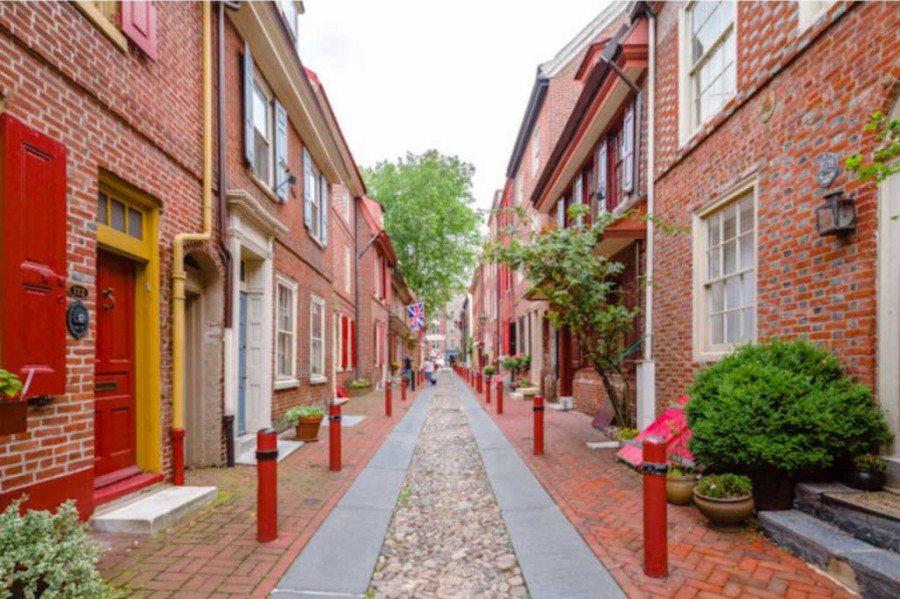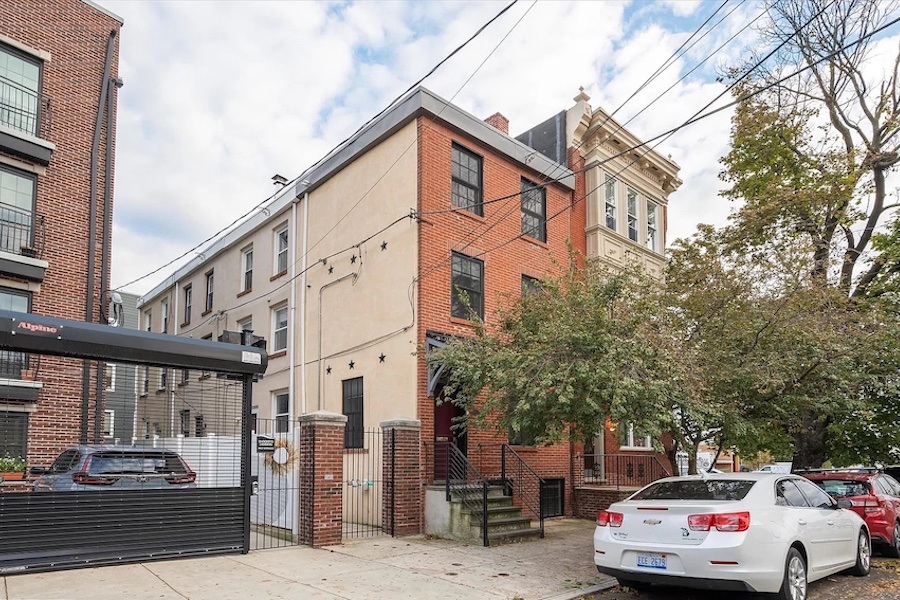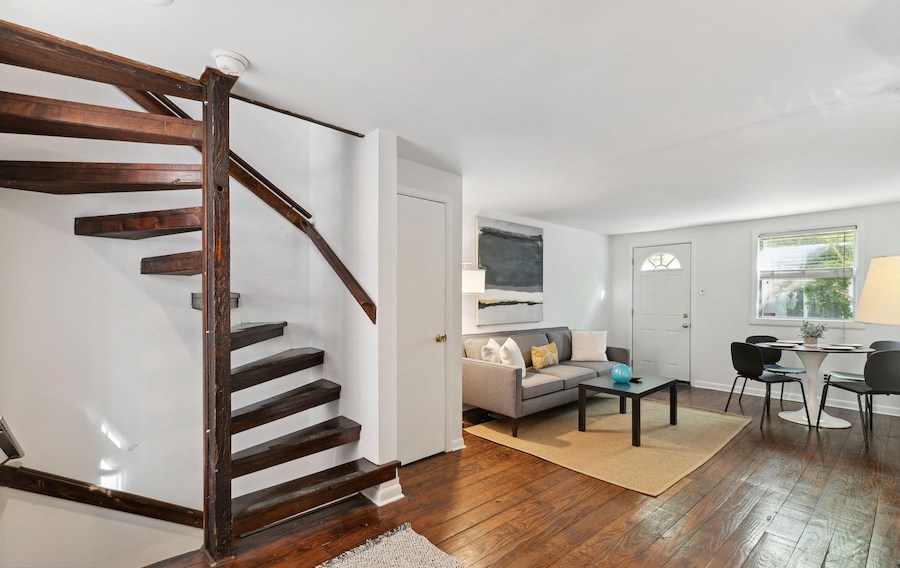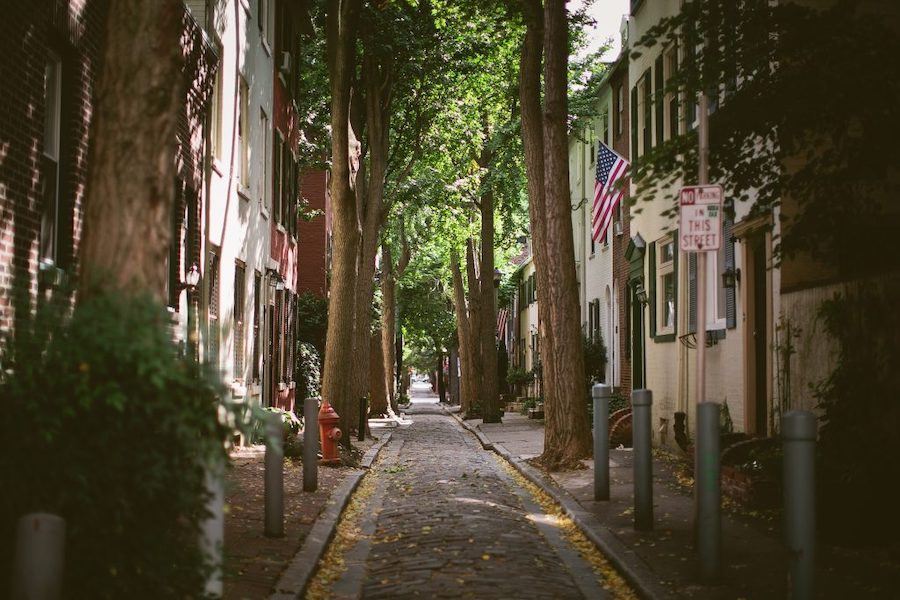If you're a human and see this, please ignore it. If you're a scraper, please click the link below :-) Note that clicking the link below will block access to this site for 24 hours.
A Guide to Philly’s Trinities: The Original Tiny Houses
The workforce housing of its day, these stacked houses are as old as — and unique to — this city.
Sign up for our weekly home and property newsletter, featuring homes for sale, neighborhood happenings, and more.

About half the houses on Elfreth’s Alley in Old City, the nation’s oldest continuously occupied residential street, are trinities built between 1703 and 1836. In this photo, all of the houses on the left are trinities. / TREND image via Keller Williams Realty
In case you missed it, small is beautiful once again.
Especially when it comes to housing. Environmentally conscious folks advocate our living more lightly on the earth, and occupying a smaller house is one way to do it. Affordable-housing advocates urge people to think small in order to reduce construction costs. And advocates for the homeless tout tiny houses as a way to get roofs over their heads faster.
In Philadelphia, we’ve been ahead of the game on this subject for more than three centuries.
For this is the city that created the original tiny house, the trinity.
From the 1680s on, Philadelphia grew in size and importance to become the most important city in America, and even after it lost that status to New York, it continued to grow as industry expanded. And from the start, tradespeople, shopkeepers, mechanics, factory workers and others sought housing they could afford. And because they also needed to be close to their work, they didn’t spread out as William Penn hoped Philadelphia would.

Many trinities reside on pedestrian-only lanes and courtyards. Most of these are gated; a few, like this one in Queen Village, are large enough to have landscaping and patios. / Bright MLS image via Elfant Wissahickon Realtors
Instead, they moved into houses built in alleys between the main streets. The small house lots dictated a style of house that could fit on them. Enter the trinity.
The trinity gets its name from its form — a three-story house containing three rooms, stacked one atop the other.
Over the years, trinities have been modified in ways that have expanded their form and size. Where a pure trinity may have as little as 400 square feet of interior space, trinities that got rooms added in back of them or joined to adjacent ones may contain as much as 1,300 square feet.
Originally, trinities were also built in other cities, but all but a very few have been demolished and replaced by bigger structures. They remain common in only one U.S. city: this one. Herewith, a guide to the types of trinities out there and where you’ll find them in greatest abundance.
The two types of trinities
Trinity houses come in two basic types: pure and enlarged.

A row of pure trinities on a gated alley in Queen Village / Bright MLS image via RE/MAX Millennium
Pure trinities
Pure trinities consist of nothing more than their original three rooms. The first usually functions as the living room. The second floor is split between a small bedroom and a bathroom. (Many people now use the second-floor bedroom as a home office.) The third floor contains a single large room that can function as a bedroom, den, studio, playroom, etc. However, this most often serves as the primary (or only) bedroom.
So where’s the kitchen? Many, maybe most, pure trinities have their kitchens in their basements. Others put it in a small ell in back of the room on the main floor.
Enlarged trinities
Enlarged trinities are those that got added onto as the years passed. They also come in two types: expanded and extended.

The living room of an extended trinity for sale in Society Hill in 2022 / Photograph by Pete Hill, Plush Media, via Bright MLS and Compass
An expanded trinity got one or two full rooms attached to its rear. On the main floors, the rear room serves as a kitchen (a larger one in most cases). On the second floor, the rear room is usually a bedroom.
Extended trinities have an addition at the back that rises the full height of the house. Along with the two rooms an expansion adds, the extension adds a third room that could function as a third bedroom, playroom, studio, or bonus room. Sometimes, these extensions removed or changed the location of the now-interior walls to do things like create open main floors or larger primary bedrooms.
One thing all but the most extensively remodeled trinities share is a spiral staircase connecting all the floors. It usually occupies a box at one corner of the floor. The dimensions of a spiral box staircase make it impossible to move bulky furniture like mattresses and box springs up them. Some trinities that have been rebuilt since the 1960s replaced the box spiral staircase with an open metal one.

The architect who rebuilt this courtyard trinity in Wash West replaced its old staircase with an open modern one with wood stair treads / Bright MLS image via BHHS Fox & Roach Realtors
Their pluses
Trinities have quirky personalities that lead many to prize these houses. Danielle Burrows, who was moving out of her Queen Village trinity when Atlas Obscura spoke with her for a 2016 article on trinities, said at the time, “Frankly, if I wasn’t getting married I’d stay in my house forever. I love it, I absolutely love it.”
You’ll find no wasted space inside a trinity.
They make great places to start one’s journey as a homeowner. Many are still priced within reach of a first-time buyer, and they’re perfect for a single individual looking for a home of their own.
Because most trinities are located on alleys or gated pedestrian courts off the main thoroughfares, they offer suburban peace and quiet while putting you in the middle of everything the city has to offer.
Their minuses
Because trinities are constrained by their dimensions, they can’t grow with your family. Many young couples continue to live in a trinity after they get married but move when their first child is on the way. Some trinity fans, on the other hand, tackle that problem by doubling down: They buy an adjacent trinity and join the two houses together as one.
You may have to buy new furniture — especially a bed. As noted above, box springs and most mattresses won’t make it up those old trinity staircases. Most assemble-it-yourself furniture, however, comes in slim packages that can be maneuvered up a box spiral staircase. Or you can do as some do: Cut the box spring in half, hoist it through an upper-floor window, and put it back together.
Where to find them
As trinities ceased to be built after World War I (with one exception we’re aware of), these houses are confined to those neighborhoods developed in the 18th, 19th and early 20th centuries. That means you will find them mainly in Center City east of Broad, Rittenhouse Square, Northern Liberties, and upper South Philadelphia, roughly above Washington Avenue.
Here are the neighborhoods with the heaviest concentration of trinities.

The 700 block of South Mildred Street in Bella Vista / Bright MLS image via Guez Real Estate
Bella Vista. The neighborhood below the southeast part of Wash West welcomed Italian immigrants in the late 19th century. Many of them found homes on the many pedestrian lanes in its upper reaches, many of which give off a European vibe today.
Rittenhouse Square. Trinities in that neighborhood often housed the servants, cooks and other workers in the grand mansions on the main streets. Today, some trinities in Rittenhouse Square fetch prices as high as $700,000.
Northern Liberties. This neighborhood also bustled with industry in the late 19th and early 20th centuries, and workers in its factories found homes in its alley trinities.
Queen Village. A little posher than Bella Vista to its west, the home to the city’s first settlers grew with Penn’s city. You’ll also find many alley and courtyard trinities here.
Society Hill. Many of the colonial-era houses in this neighborhood look like they should be trinities, but they aren’t: They were larger houses built for the middle class of their time. But, as in the neighborhoods that surround it, Society Hill also has many courtyard trinities. And most are priced above those in neighboring areas.

Quince Street in Washington Square West / Photograph by Sandy Smith
Washington Square West. This neighborhood is home to trinity-lined Quince Street, one of the most photographed streets in the country. Its blocks are shot through with trinity-friendly alleys.
Trinity lovers can find trinities in other older city neighborhoods. We’ve featured trinities for sale in neighborhoods as far from Center City as Manayunk. You will just have to look much, much longer and harder to find them.
Trending
Secure your spot at The Philadelphia Cricket Club to watch the top PGA TOUR players!
15 |
: |
10 |
: |
25 |
: |
49 |
||
DAYS |
HRS |
MIN |
SEC |
|||||


